South Africa is a truly spectacular country. The diversity the nation provides in terms of landscapes, cultures and experiences is remarkable. As you travel through South Africa, you never quite know what awaits you from day to day from oceans and lakes to mountains and deserts, from sprawling metropolises to remote villages, which is precisely what makes it such an irresistible travel destination. South Africa travel has become more accessible, particularly since the country hosted the World Cup in 2010 and its subsequent boom in international visitors.
Our South Africa road trip was, without a doubt, one of the best travel experiences I’ve ever had. We drove from Johannesburg to Cape Town, and flew to Kruger National Park to cap off our trip, and added in the small mountain nation of Lesotho along the way. This trip was the result of extensive planning; pouring over travel forums, reading through guidebooks and collecting recommendations from fellow travelers. I know firsthand how daunting it can be to plan an experience like this, which is why I want to share as much as I possibly can to make it easier for you.
So on that note, if you’re embarking on your own South Africa travels, here is everything you need to organize a road trip of your own.
South Africa Road Trip Guide:
Planning your South Africa Road Trip
Determining your route: I recommend starting in Johannesburg and working your way to Cape Town instead of the opposite. This way the drives are longer near the beginning of your trip when you have the most energy. And though the scenery is wonderful throughout the route, it does become even more spectacular as you get closer to Cape Town.
How long to go for: We spent three and a half weeks in South Africa, which was comprised of a two week road trip with a few days in both Johannesburg and Cape Town without a car on each end, and four nights in Kruger. We opted to stay in most places for two nights on our road trip, with only a couple of overnighters. While I’m happy we were able to see as much as we did, the driving portion did feel a bit much at points. We certainly could have added a few buffer days to some of our stops to make it more relaxing. So if you’re leaning towards packing in more by doing just one night in each, I would strongly advise against that.
Type of experience: With such a diverse landscape, the array of travel experiences in South Africa is seemingly endless. Whether you’re after a big city, remote natural setting, beach vacation, adventure activities, winery visits, or safariing you’ll find it here. The beauty of a South Africa road trip is that you can incorporate many of these things into your itinerary as we did, though if you’re interested in a particular type of experience, it will help you narrow down your route.
Popular experiences that tend to guide visitors’ South Africa travels are unique animal excursions (swimming with sharks, ostriches in Oudtshoorn, Addo Elephant Park, whale watching, or a ‘big five’ safari), beach & surf vacations (Cape Town, Wildcoast, Jeffrey’s Bay, Plettenberg Bay, Knysna), food & drink (Stellenbosch, Cape Town, food tours), cultural immersion (Johannesburg, Durban, Wild Coast), and adventure activities (bungee jumping, mountain biking, hiking, rafting, kayaking).
When to go: Determining when to visit can be tricky and weather can vary significantly throughout the country. Summer (December to March) will be the warmest but the wettest, making it a less ideal time for a safari. The summer months can also be rammed with international tourists, particularly on the Garden Route. The winter months (June to August) provide a welcome reprieve from the heat and ideal safari conditions, though the Western Cape coast experiences significant rain at this time. The spring and fall offer a middle ground and are a nice time to visit.
Consider the local holiday schedule as well as South Africans love to travel within their country whenever they can, leading to a significant spike in travelers. There’s a school break mid-December to mid-January, holidays that coincide with Easter, and a month off in mid-June to mid-July. Being mindful of the fact that we were traveling in January, we opted to save our time in Kruger until after the school holidays as it often is rammed at that time of year, even though it wasn’t ideal from a route perspective.
Accommodation options: Your options of where to stay during your South Africa travels runs the gamut from camping to luxury lodge, and we stayed at pretty much every end of the spectrum. Hostels are an option in the bigger cities and the backpacker towns in the Wild Coast and Eastern Cape, while guesthouses are particularly popular throughout the Garden Route. We planned our trip to include many of South Africa’s National Parks, most of which offer unique accommodation options and a rare opportunity to stay the night even after the park is closed for other visitors.
Car rental: We rented a car from the Johannesburg airport and because we were trying to keep costs down we opted for an economy level vehicle. I did some research before booking on what cars other South Africa road trippers drove on their adventures, and many used compact cars without issue. While we didn’t have an issue with our little Ford Fiesta, there were times when I thought it wouldn’t make it over an intensely potholed road or up a super steep hill, or my biggest fear – that we would breakdown on the side of the road after dark in a remote area. Looking back, I would have sprung for a larger car, at least for peace of mind.
We rented from Avis and got a great rate – which included all insurance, something you don’t want to go without in South Africa. If you’re heading into another country on your South Africa road trip like Lesotho, Swaziland, Namibia, or Botswana, make sure you inform the rental agency as you will need a document to show at the border.
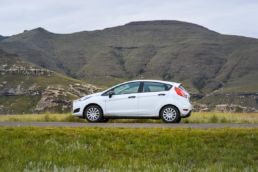
South Africa Road Trip Itinerary
Johannesburg
Though many travelers dismiss Johannesburg, mostly due to its dangerous reputation, it was a highlight of our time in South Africa. Joburg is a city that’s evolving rapidly, the result of a young and creative population who aren’t satisfied with the status quo. The city is a burgeoning hub for arts, dining, and, increasingly, craft beer. Through this evolution, Johannesburg retains its strong cultural heritage.
Apartheid Museum / A visit to the Apartheid Museum should be a non-negotiable in your South Africa itinerary. This testament to the horrifying treatment and segregation of non-white South Africans strikes the right balance between emotional and powerful.
Soweto / South Africa’s most notorious township is rooted in history and brimming with culture. There is so much to see and learn in this vibrant community and the best way to do that is through a tour. Leading hostel Lebo’s Soweto Backpackers offers an immersive and informative bike tour that’s one of the best ways to experience the township.
Constitution Hill / Many activists, political prisoners and apartheid offenders were locked up in the prison built on the site of this former fort throughout much of the 20th century. The conditions at Constitution Hill were deplorable and the treatment despicable. There are different guided tours to choose from depending on your timeline and interests.
Maboneng Precinct & Arts On Main / After nearly two decades of being a ghost town, an interest in revitalizing the neighbourhoods of Johannesburg’s Central Business District (CBD) arose, and Maboneng was one of the first projects. The rejuvenation of Maboneng was spearheaded by the opening of the creative and artistic space Arts On Main in a former factory building. Today, Maboneng features hip restaurants and cafes, indie clothing boutiques and an all around cool vibe.
Neighbourgoods Market / Every Saturday Neighbourgoods Market sets up in a converted building in Braamfontein from 9am to 3pm. A mix of food stalls, artistic vendors and craft beer is showcased over multiple levels. A large outdoor space is filled with tables that fill up quickly as it’s the hippest spot to be in Joburg on a Saturday. The neighbourhood, ‘Braam’ to locals, is also filled with cool shops, eateries and galleries.
Where to Eat: Coobs (Parkhurst), Tashas (Rosebank & other locations), The Local Grill (Parktown), Canteen (Maboneng), Cafe Picobella (Melville), Stanley Beer Yard (Millpark).
Stay: Curiocity Backpackers. Named the best hostel in South Africa, Curiocity was built by the passion of a young entrepreneur in the heart of Maboneng. Set in a converted industrial building, Curiocity offers a variety of room types from private to dorm, and an abundance of shared space.
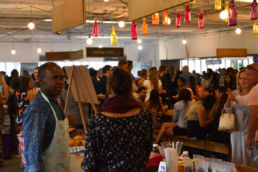
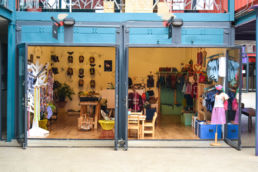
Johannesburg → Tsehlanyane National Park, Lesotho
Distance: 370 kilometres / 230 miles
We were intrigued by Lesotho because of its rich culture and mountainous landscape. While looking at how to fit it into our itinerary, we considered including the capital Maseru in the west and the Sani Pass in the east, which is accessible through the Drakensberg Mountains. The route seemed difficult and timely, though. Ultimately, we decided on Tsehlanyane National Park due to its location near Golden Gate Highlands National Park, the nature and wildlife in that area and the impressive Maliba Lodge.
The drive from Johannesburg through the Free States is easy on a relatively smooth highway. There aren’t many cars and towns are few and far between. The Caledonspoort border crossing is pretty straightforward and quick, for us at least. Driving into Lesotho, the road is paved, though it can take longer as people, and animals, often walk along it.
Stay: Maliba Lodge. We spent our three days at Maliba Lodge, Lesotho’s only five star resort, at both extremes: hiking in the remote National Park and relaxing on the patio of our rondeval. The food is fantastic and the staff, mostly local, are magnificent. It’s certainly a splurge at $300 USD per night (includes all meals), but relative to what you’d pay for similar quality elsewhere, it’s a value. Other than the great hiking nearby, there are other activities offered at Maliba including Basotho pony trekking and visit to the local Basotho community.
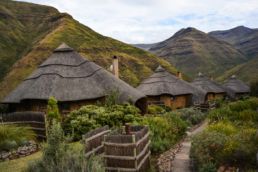
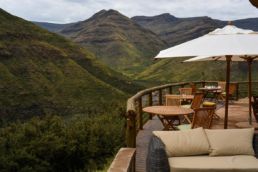
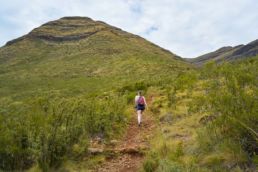
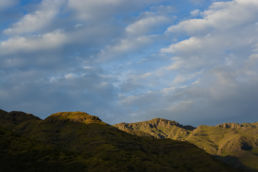
Tsehlanyane National Park → Golden Gate Highlands National Park
Distance: 110 kilometres / 70 miles
After venturing back the way you came and through the border crossing once again, veer right on the R711 toward Golden Gate Highlands National Park. The scenery is striking, with vast plains and looming mountains in the distance.
Just twenty minutes before the Golden Gate is Clarens, an artsy little town that’s a popular holiday destination for South Africans. Stop in for lunch, peruse the many shops and grab a pint at the popular Clarens Brewery. Many travelers base themselves here and explore nearby Golden Gate Highlands National Park. Alternatively, if you’re staying on the park grounds, buy any groceries you might need in Clarens before moving on.
The Golden Gate Highlands National Park is a special place. The landscape is punctuated with huge, bright orange sandstone mountains that looks other-wordly after centuries of erosion. There are two self-drive loops in the park, which bring visitors face to face with the animals that roam here including Black Wildebeest, Eland, and a few Bok species. There are several great hikes within the park at varying levels of difficulty. While it’s a shame that it’s not on the radar of many international tourists, the peace and quiet the park provides is wonderful.
Stay: Highlands Mountain Retreat. One of the greatest things about South Africa’s national parks are that many offer their own accommodation. Often these are unique huts or lodges, and they provide an opportunity to stay in the park after the gates are closed to day visitors. Accommodation options at Golden Gate Highlands National Park include a new modern hotel, rondavels (traditional Basotho huts), camping, or the spectacular log cabins perched on a mountain that we opted for.
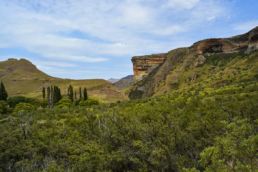
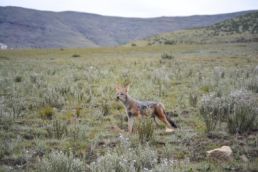
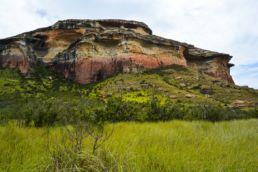
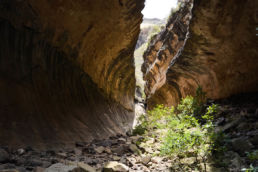
Golden Gate Highlands National Park → Drakensberg Mountains
Distance: 170 kilometres / 105 miles
The drive from Golden Gate Highlands into the Drakensberg Mountains is largely uneventful. The roads are quiet and the scenery nice.
The Drakensberg Mountain range is over 1,000 kilometres long, full of high peaks, lush valleys and epic waterfalls. During the summer everything is vibrantly green and the nightly sunsets are mesmerizing. As the area is so large, there are several areas to base yourself and explore in depth including Giants Castle, Ukhahlamba, Cathedral Peak, and Monks Cowl.
We based ourselves near Giant’s Castle Game Reserve, a large park with dozens of hiking options. The area features waterfalls, fresh water pools, green peaks, deep cave and ancient rock art. With so much to do within this large space, you can easily spend days exploring the trails of Giant’s Castle.
Stay: Inkosana Lodge. This lodge offers a range of accommodation types including camping, shared dorms and private huts. The vibe at Inkosana is definitely one of community, and the owner helps to foster this with his welcoming and helpful approach. There’s a lot of space on the grounds to relax and a large fresh water pool is the place to be when the temperatures rise. While the shared kitchen allows guests to make their own food, Inkosana also serves breakfasts and dinners.
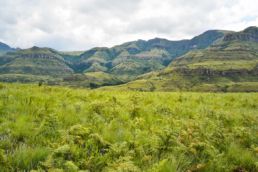
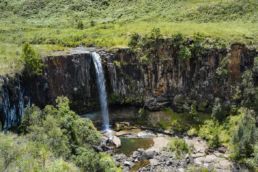
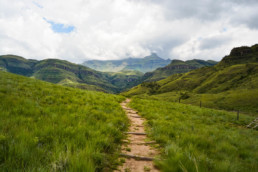
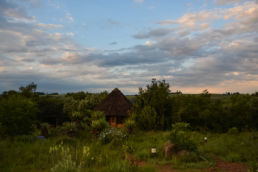
Drakensberg Mountains → Coffee Bay
Distance: 600 kilometres / 375 miles
A word of warning – this is a rough day of driving. The road is pretty easy until you’re in the Eastern Cape, where every town seems to spill into the streets, sheep threaten to run in front of your car, and the roads are dotted with huge potholes. Don’t follow the Google Maps directions to take the R617 at Howick and instead carry on to Pietermaritzburg to catch the R56. If you can swing it, I would strongly suggest you add in a night or two in between, either in Underberg, where you can experience more of the Drakensbergs and the Sani Pass, or Durban.
The Wild Coast is part of the coastal region of the Eastern Cape. Home to the Xhosa culture, the region has a rich heritage, and because it’s relatively undeveloped, it’s a virtually unspoilt natural setting. Also known as The Transkei, this region played a pivotal role in the abolishment of Apartheid.
Stay: Coffee Shack. This popular backpacker spot is the type of place where people come for a night and stay for a month. The vibe here is welcoming, casual and social and its mission of sustainable tourism makes it even easier to support. The property is large, accommodating many travelers in its dorms, private huts and camping ground, while the shared spaces are socially focused. Coffee Shack is right on the ocean and offers surf lessons.
If you can spare two additional nights, the guided hike along the coast between Coffee Bay and Bulungula is a phenomenal experience. You depart from Coffee Shack, visiting the famous ‘Hole In The Wall’ on route to Wild Lubanzi Lodge where you spend the night. The next day you trek to Bulungula Lodge, where your luggage is waiting for you.
Coffee Bay → Chinsta
Distance: 260 kilometres / 160 miles
Chintsa is another town on the Wild Coast, about a four hours drive west of Coffee Bay. It’s a small village that attracts a mostly backpacker clientele drawn to its pristine beaches, relaxed demeanour and excellent lodging at Buccaneers.
While relaxing on the beach and enjoying a slower pace may be all you need, there are some fun things to do in the area. Nearby Inkwenkwezi Game Reserve offers ‘The Big Five’ game drives and experiences, while whale and dolphin watching is possible during the winter months. Cultural tours of traditional Xhosa villages provide a unique opportunity to experience local life. A local brewery serves up a variety of beers and offers tours of their facilities located on a farm near Chintsa.
Stay: Buccaneers Lodge & Backpackers. A favourite among backpackers, Buccaneers is a major reason tourists end up in Chintsa. They offer a range of sleeping options from cottages and ensuite rooms to dorms and safari tents, essentially providing something for every budget. The restaurant at Buccaneers serves up great meals daily, and the bar and pool area are social spots. Expect to be deeply relaxed after your stay.
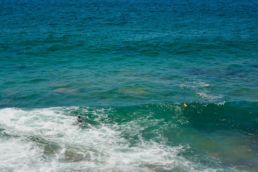
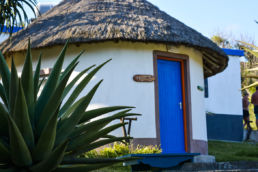
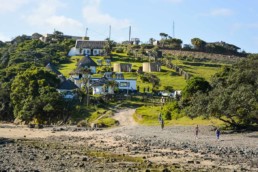
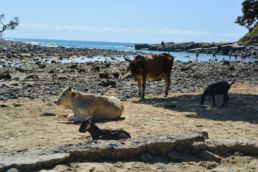
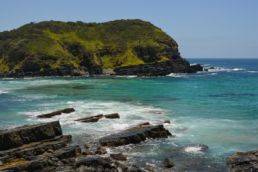
Chinsta → Storms River
Distance: 500 kilometres / 310 miles
While there’s a lot of distance to cover, the drive to Storms River features stunning views of the coast. Stop for a bite in Jeffrey’s Bay, a popular surfing town and visit the aptly named Paradise Beach for a quick swim. J-Bay Bru Co in the centre of town offers a great menu and a diverse range of local craft beers.
Though you’re still in the Eastern Cape, Storms River is right near the Western Cape border and is considered the start of the popular Garden Route. Storms River is within the Tsitsikamma National Park, which is part of the larger Garden Route National Park.
The natural surroundings at Tsitsikamma are magnificent. Right on the Indian Ocean, the National Park offers excellent views and the potential to spot dolphins, otters and porpoises. Watersports are on offer such as swimming, kayaking and snorkeling. A suspension bridge high above the water is a must do, while the hike in the surrounding forest to Agulhas Look Out offers a spectacular view after a grueling uphill hike.
Stay: Storms River Mouth Rest Camp in the Tsitsikamma Garden Route National Park. Again, staying in one of South Africa’s National Parks pays off with an unparalleled opportunity to stay right in nature. We chose a ‘Forest Hut’, which was a log cabin with a kitchen, table, two twin beds and a private bathroom.
Storms River → Wilderness
Distance: 140 kilometres / 85 miles
The drive between Storms River and Wilderness is quite easy though it can be a busy route during peak Garden Route season in the summer and around holidays. There are several potential stops along the way including Nature’s Valley (a small village with beautiful beaches), Plettenberg Bay (a sizeable resort town) and Knysna (a town with a great coastline).
The Garden Route National Park is comprised of four distinct sections, with Wilderness being the furthest west. It features beaches, rivers and forests, while its vast array of bird species makes it a prime spot for bird watching. Visitors can partake in a variety of activities including canoeing on the river, fishing, paragliding or hiking one of the park’s many trails.
Wilderness offers some good dining options in town, particularly The Girls Restaurant and Flava Cafe & Restaurant, and don’t miss The Blind Pig & Bootlegger Brewery for a taste of local craft beer.
Stay: Ebb and Flow Rest Camp in the Wilderness Garden Route National Park. We again elected to stay in the Garden Route National Park and enjoyed its rustic yet homey accommodations. Options range from tents to family sized log cabins, and we opted for a ‘Forest Cabin’ with two twin beds and a patio overlooking the river.
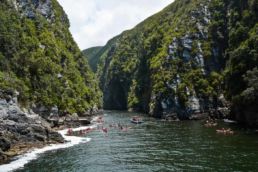
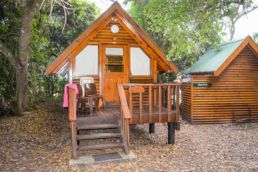
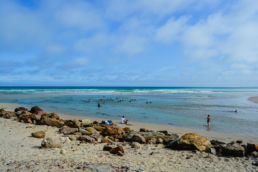
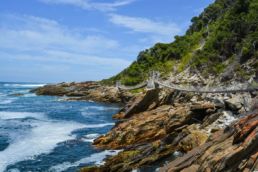
Wilderness → Karoo National Park
Distance: 250 kilometres / 155 miles
Heading North into the Karoo is a marked detour from the Garden Route that not many visitors attempt, though they are missing out. An arid desert of open plains and stifling heat, the Karoo is unlike any other area of South Africa.
Along the N12 you’ll reach Oudtshoorn, a popular spot for visitors while on a South Africa road trip. Known as the official ostrich capital of South Africa, Oudtshoorn features an abundance of ostrich farms, some of which offer the unique experience of ostrich riding, if you’re into that.
Just past Oudtshoorn you will drive through the most incredible rock formations in the Swartberg East Nature Reserve, while passing baboons lingering on the side of road. Here you can park your car and take a short walk to the Meiringspoort Waterfall. Not only will you be rewarded with great views, but the pools are swimmable.
As the mountains become increasingly small in your rear view mirror, the terrain shifts to flat and dry, with little sign of life – both human and animal. Even in the crowded summer season, the Karoo offers a quiet that is unattainable elsewhere, though the tradeoff is often scorching heat.
The Karoo National Park is a marvel. It’s a huge expanse of arid terrain, with determined plants able to survive in this harsh environment adding specks of colour to the landscape. There are a few self-guided drive routes throughout the park, though only Klipsringer Pass is accessible without a 4×4 vehicle. There are a plethora of animals within the vast Karoo National Park, including a tribe of elusive lions that were reintroduced into the area after going extinct in the mid 19th century.
Stay: Karoo National Park. While visiting the Karoo National Park is an epic experience, staying on the grounds is unforgettable. With just a few traditional Cape Dutch chalets and a campground, the vastness of the park is even more pronounced once the day visitors take off and the park’s gates are closed. The chalets are the most modern accommodations we stayed in any of South Africa’s National Parks, and the huge patio out back offers stunning views, especially during sunrise and sunset. Don’t worry, there’s an electric fenced perimeter to keep the lions out.
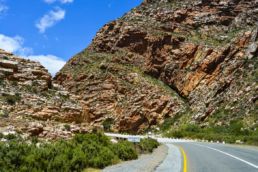
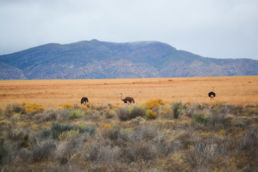
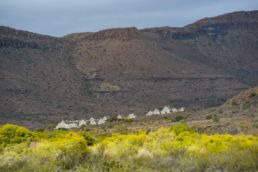
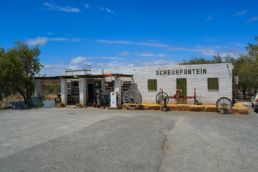
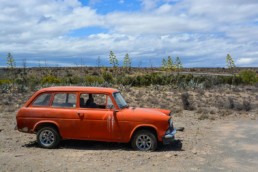
Karoo National Park → Barrydale
Distance: 350 kilometres / 220 miles
There are two options for heading toward Barrydale. The first is along the N1 from the Karoo National Park while the other is heading back down the N12 towards Oudtshoorn. We opted for the latter and retraced our steps as it allowed us to drive Route 62, often referenced as South Africa’s version of Route 66 in the US.
Route 62 is a highway filled with quirky stops, scenic sights and sleepy towns set amongst the desert. Local markets and shops known as padstals line the route where you can find an assortment of goodies from novelty to antique, as well as homemade food stuffs. Be sure to make a stop at Smitswinkel Farm Village, Bella de Karoo, De Kloof Padstal, and Clarke of the Karoo.
Route 62 is known for its wine with the Klein Karoo Wine Route featuring several wineries and distilleries just off the highway, with the highest concentration near Calitzdorp. Don’t miss De Krans Wines, Boplaas, and Calitzdorp Cellars.
Before you reach Barrydale, you’ll come across the infamous Ronnie’s Sex Shop. Though not as its name implies, Ronnie’s is a local bar on Route 62. Every square inch of the walls inside Ronnie’s is filled with writing, the lasting mark of previous visitors. Though if you want to leave something a little more substantial, you can add your undergarments to the throngs of bras and underwear hanging from the ceiling. The huge sign lures travelers in and the great patio out front and cold beer keeps them there.
Barrydale is a small town that embodies the quirkiness of Route 62. It’s a town of arts, culture and farms. Take a tasting at local wineries Joubert-Tradauw and Barrydale Cellars, visit the artisan shops such as Barrydale Hand Weavers, Mathilde and Co., and Inkaroo Jewellery. For breakfast or lunch don’t miss the quirky Diesel & Creme for diner classics and delectable milkshakes, while dinner at the Mediterranean Mez Karoo Kitchen is a must.
Stay: Karoo Moon Motel. On the same grounds as Diesel & Creme is this small B&B set in a refurbished building. With only a few rooms, a communal kitchen and a great lounge it feels like home. The abandoned gas station out front befits the 50s nostalgia theme while the antique salvaged and reclaimed pieces of furniture inside add to the charm.
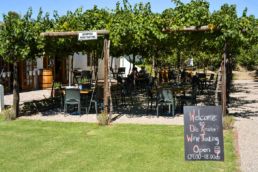
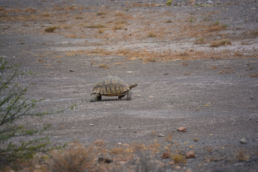
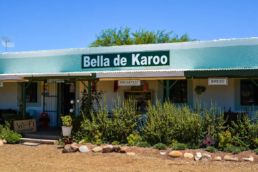
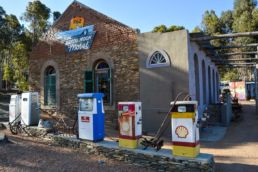
Barrydale → Stellenbosch
Distance: 215 kilometres / 135 miles
You’ll finish the final section of Route 62 today, passing through more small towns, stopping in at local farm stalls and perhaps visiting a few wineries around Ashton and Robertson. Once you’re back on the N1, you’ll be driving through the stunning Hawequas mountain region.
Stellenbosch is a popular base for travelers looking to explore the infamous Cape Winelands. It’s a lovely city, and decently sized with an array of restaurants, shops, and cultural sights to offer besides wine. Many visitors looking for a more remote setting within the wine region look to nearby Franschhoek or Paarl, though if your time is limited they may be less than ideal as a base. A regret of mine is that we only spent one full day in the area, which did not provide nearly sufficient time to explore the surrounding area or discover some of the off-the-beaten-path wineries.
As our time was limited, we opted for a Vine Hopper Wine Tour. This is an excellent option if you don’t have a lot of time in Stellenbosch and you want to get a feel for the region. Vine Hopper offers three routes, which vary daily, and takes guests to up to six wineries. The beauty of Vine Hopper is that it’s ‘hop on, hop off’ meaning you have the freedom to spend as long as you want at certain wineries or skip others entirely. We took the tour on a Saturday meaning we did the ‘Southern Route‘, which offered a great balance of both large and small wineries, fantastic views and, most importantly, excellent wines.
Stellenbosch and the surrounding region has a great food scene with some of the best restaurants on the continent. For an unforgettable dining experience there’s Rust en Vrede, Clos Malverne and nearby Babel. For something a little more accessible try local favourites Oppie Dorp, Mont Marie and Basic Bistro. Breakfast at super popular Schoon de Companje is a must. For something super special arrange a personal picnic at Spier Winery – a highlight of our time in Stellenbosch.
Stay: Eendracht Hotel. This was the only traditional hotel we stayed at during our South Africa road trip. The building is beautiful, with a dozen rooms that have been modernized over the years and a fantastic location right in the heart of Stellenbosch. The staff were lovely, the service wonderful and the breakfast included.
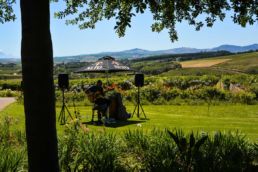
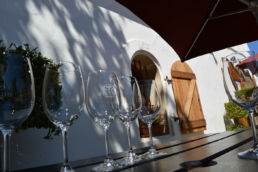
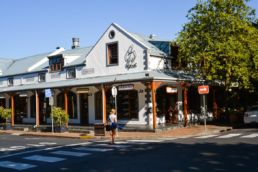
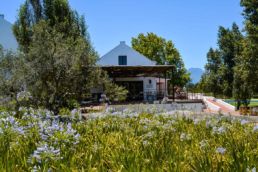
Stellenbosch → Cape Town
Distance: 50 – 150 kilometres / 30 – 95 miles
Instead of driving straight to Cape Town we detoured to see more of the Cape Peninsula. The R310 is a great scenic road that runs alongside the coast and through small towns. Turn left on the M4 and make a stop at St. James Beach, Kalk Bay, Fish Hoek, Simon’s Town, and Boulders Beach, where you can watch the most adorable penguins enjoying life in the sand. Another 30 minutes south and you’ll arrive at Cape Point Natural Reserve, a magical spot where you’ll have fantastic views of the ocean. Once we arrived in Cape Town we returned our rental car as we didn’t need it while in the city.
Cape Town receives its fair share of hype, though it manages to live up to it. It’s a vibrant city that offers a variety of experiences including nature and scenery, cultural and historic, and creative and trendy. The food scene is great in the city with an abundance of options from traditional to modern.
Table Mountain / This flat-topped mountain is one of Cape Town’s most iconic landmarks, visible from many parts of the city. Take a cable car up to the top or you hike it in about two hours, where you’ll be rewarded with stunning views over the city and ocean.
Lion’s Head / The summit of Cape Town’s other mountain, Lion’s Head, is only accessible on foot. This 90 minute hike is moderate and the views from the top are impressive.
Kirstenbosch National Botanical Gardens / A nature oasis in the centre of Cape Town, Kirstenbosch is a peaceful place to spend a few hours while in town. The biodiversity in the gardens and forests is spectacular.
Bo-Kaap / This area of Cape Town was once a township for the city’s Malay population. The district is distinctive not only because of its history, but also the brightly coloured houses that line the streets. Some of the city’s best restaurants are located in Bo-Kaap.
District Six Museum / Cape Town’s turbulent history during apartheid was exemplified in District Six, which originally settled by a myriad of cultures saw 60,000 forced removals of individuals residing there. Today, the Museum serves as a reminder of the damage inflicted during this era.
Victoria & Alfred Waterfront / All visitors to Cape Town will find themselves at this iconic harbour at some point. The V&A Waterfront is buzzing from morning to night with several restaurants overlooking the ocean, ships waiting to take visitors on boat tours and two excellent markets to peruse: the V&A Waterfront Food Market features a few dozen food stalls offering a variety of cuisines, and the Watershed Market is an enormous space where independent artisans can sell their one of a kind wares.
Shopping & Markets / Neighbourgoods Market (Saturdays), Biscuit Mill, Salt Circle Arcade, Woodstock Exchange, and Woodstock Foundry.
Where to eat in Cape Town: Clarke’s Bar and Dining Room, Chef’s Warehouse, Black Sheep Restaurant, Kloof Street House, Biesmiellah, Yard, Truth Coffee, Pot Luck Club
Stay: We rented this Airbnb in Green Point and loved it. Woodstock or Kloof Street are also ideal areas to base yourself in Cape Town as they’re in and around the action.
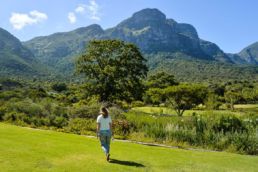
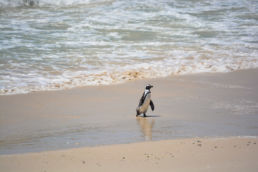
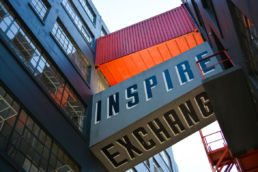
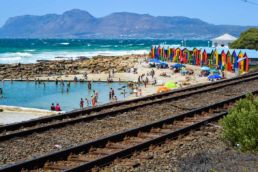
Cape Town → Kruger (Fly)
Though there are other game parks in South Africa, many of which were probably more convenient given our route, Kruger was a non-negotiable for us. After going back and forth on whether to stay at a game lodge or go the self driving route, we decided to do both: two nights at a rest camp within Kruger National Park and two nights at a private game lodge.
A lot of planning went into choosing the two accommodations as we didn’t want them to be too far apart from each other (Kruger is massive) or the airport. We flew into Hoedspruit and rented another car, this time a sturdier Volkswagen Jetta, to drive on safari. Anyone with a vehicle who pays the entrance fee can enter Kruger and drive throughout its many roads and paths. It’s a fun time driving around and looking for animals, pulling your car over to marvel at the ones you do encounter, or hightailing it out of there if an elephant comes charging at you. You can purchase an animal guide that displays each species within Kruger so that you understand what you’re looking at. Gate hours are from 5:30 – 6:00 am to 5:30 – 6:30 pm depending on the time of year.
Kruger’s rest camps offer a range of activities including organized drives while the park is emptied of visitors. We went on a night drive in a large open vehicle with an experienced guide. For three hours we drove in darkness, shining flood lights into the surroundings to glimpse the nocturnal creatures in their element. Although knowing that it’s prime hunting time for major predators is slightly unnerving, it’s surreal to be experiencing the park in a way few others have the opportunity to.
Stay: Tamboti Satellite Camp. While planning our Kruger stint I wanted to stay in a safari tent inside the park as it’s such a unique experience. Orpen is the closest rest camp when coming from Hoedspruit, and its satellite camp Tamboti is the only spot nearby with safari tents.
The safari tents at Tamboti are situated alongside the Timbavati River, and with only a few dozen tents it’s much quieter than Orpen or the other main rest camps. Our safari ‘tent’ was on a wooden platform and was comfortably furnished with a double bed and a couch. We had a bathroom, a fridge, and large deck that had an outdoor kitchen and braai. The security guard warned us about the baboons and honey badgers that aggressively seek out food, destroying tents to get at it. While we kept no food in our tent, a large tail dropped down from the roof above us while we were finishing up dinner our first night, which was more than I could handle, though admittedly I’m a wimp. The grounds at Tamboti are wonderful, though if I returned I would probably opt to stay in something with solid walls.
Stay: Naledi Bushcamp. We splurged on a private game lodge as this was the tail end of our trip. While certainly not the cheapest safari option, Naledi is quite the value at $600 USD per night considering the wonderful game drives, first rate dining, excellent service and lovely accommodations. Read more about our experience at Naledi in this feature article.
Naledi is located in the Balule Nature Reserve, a private game park that has open borders with Kruger. This was an important factor in our decision as many lodges are in parks with enclosed boundaries, meaning that the same animals are always somewhere waiting to be found. While in an open system there’s never a guarantee of the animals you will see, the discovery is more natural. Each day consists of two game drives, one in the morning and one in the late afternoon, for a total of nearly eight hours on safari with expert guides that go out of their way to ensure you have a memorable experience.
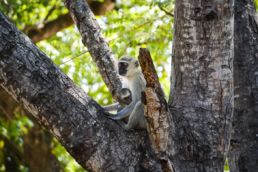
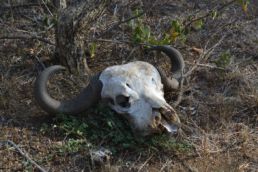
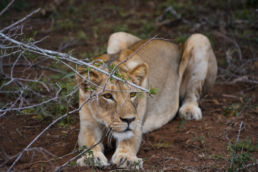
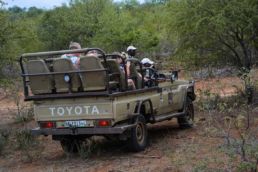
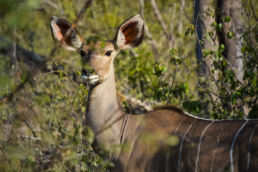
If You Have More Time
Cape Town to Namibia. The area north of Cape Town is rarely visited by tourists, though there is a lot to discover as you drive along the coast including West Coast National Park, Lambert’s Bay and Namaqua National Park. Namibia was high on our list but we just didn’t have the time to fit it in on this trip.
Tankwa Karoo National Park. The Karoo National Park was one of our favourite experiences during our South Africa travels, and I would have loved to explore the region further. Tankwa Karoo National Park is in the western part of the Karoo and is a remote, rural and beautiful place in nature.
More Kwazulu Natal and the Wild Coast. Taking a detour to the Wild Coast is timely and cumbersome, though its culture and rugged beauty more than compensate. I would love to take a couple of weeks to lay low in this region exclusively, adding in stops in Mdumbi, Port St. Johns, and Morgan’s Bay.
South Africa Road Trip Tips
Be wary of shortcuts. Most of the roads are in good condition, so long as you stick to the main highways. Sometimes what can look like a shortcut on the map will take significantly longer due to excessive potholes, which we found out the hard way.
Add in buffer time. Drive time estimates are never accurate. I always increase the time that Google Maps gives me by at least a third to reflect road conditions, traffic, and stops.
Ensure it’s safe. Safety while on the road is something to be mindful about. While everyone we came across were lovely and helpful, there are definitely less safe spots to drive through, particularly Johannesburg.
Don’t drive at night. Driving anywhere that you’re not familiar with at night is never a good idea, though depending on where you are in South Africa, it can be downright unsafe. Local roads may be unlit and there’s a risk of animals darting across too. And there’s increased crime at night.
Have a cell phone on the road. You can bring any unlocked phone or pick up a cheap flip phone when you arrive. South Africa is a bit odd in the fact that you can’t buy a SIM card, rather you rent them from the service provider, usually at the airport. They set you up with a calling and data plan, and you return the SIM card on your way out of the country.
Have a few direction aids. We didn’t have GPS in the car and Google Maps worked well for the most part. We also had a full paper sized map that we pulled out often to ensure we were on the right route, or when we didn’t have reception.
Have cash on hand. While most lodgings and large restaurants accept credit cards, it’s not universal in South Africa. Have some Rand with you always to ensure you’re never left in a lurch.
Always stop for gas. Don’t underestimate how long it will be before you can fill up as there’s likely nothing worse than being stranded in a remote part of the country. Gas stations are few and far between in some areas so always opt to be on the safe side.
Passing etiquette. South Africans have a standard way of signalling other drivers to pass them, which is helpful as many routes are only one lane. If a car is offering to let you pass, they will pull as far over onto the shoulder as possible, use their turning signal, and slow down slightly. Once you’ve passed, it’s customary to flash your headlights as a ‘thank you’.
Tip car guards. When you park your car at a grocery store, shopping mall or city street you may encounter an informal car guard who guides you into a spot and offers to keep an eye on your car while you’re gone. It’s customary to give them a tip, often a couple of Rand, as you leave.
Booking accommodations in advance. A road trip in South Africa gives you more freedom in modifying your route as you go, though I would recommend that you always book where you’ll stay at least a few days in advance. During the summer and school holidays some areas are fully booked, which we encountered when trying to find somewhere to stay in the Drakensberg Mountains over New Years. As we wanted our pick of lodgings, we booked most well in advance but we did leave a few days here and there to be spontaneous.
Bring the right stuff. Be prepared for the terrain changes and climate fluctuations that you’ll encounter when on the road in South Africa. Ensure you have hiking boots, active clothing, insect repellent, a rain jacket and a fleece even in the summer months as the nights can be cool. Visit your Doctor or Travel Clinic to ensure you have the necessary vaccines and antimalarials if necessary.
Give yourself time. We all feel pressured to see and do as much as we can when we travel, particularly on a cross country road trip. Packing too much in will mean most of your daylight hours are spent in a car. Think about the experiences that you want and add in buffer time to ensure they’re actually enjoyable. Only you can decide what pace is best.
If you’re planning your own South Africa road trip I’d love to hear about it. If you have any questions about my trip that I haven’t covered here or if anything’s come up while planning your South Africa travels, leave me a note!
South Africa Road Trip photos by JP Bervoets
Some of the links in this article are affiliate links, though we always only recommend things we fully endorse. If you’ve enjoyed this content and are thinking of a road trip in South Africa, consider using my affiliate link for accommodation so that we can continue delivering quality travel content for free. Thanks for your support!
Make your next trip the best one.
Departful is a full service travel agency creating truly exceptional travel experiences that are 100% personalized to you. Wherever you’re going, whatever your interests, we help you plan the perfect trip.
Lauren
Lauren co-founded Departful in 2012 and is the Managing Director of Departful Media. Since then she has worked between North America and Europe and has published content in partnership with a variety of tourism boards and businesses based around the world. Lauren is currently based in Toronto, Canada.
2 Comments
Add comment Cancel reply
This site uses Akismet to reduce spam. Learn how your comment data is processed.


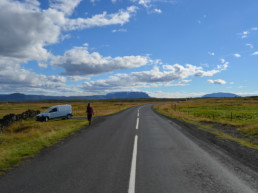
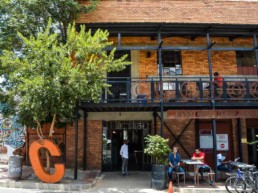
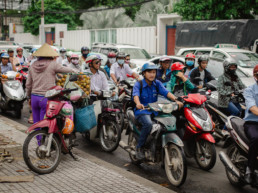
Aquila Game Reserve houses the Big 5 and showcases the wildlife of
this area like no other.
Did you manage to do a drive through the Natal Midlands? I see that you might have passed Howick. I would probably skip Durban too or leave it for a second trip, but missing the midlands which are close to the Drakensberg and 45 minutes away from Durban would be a shame.